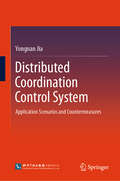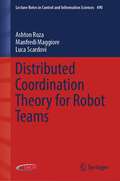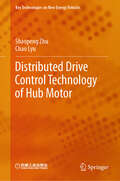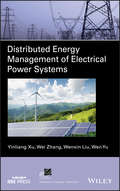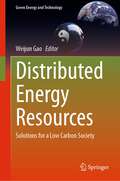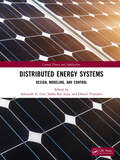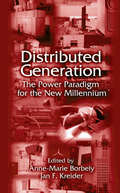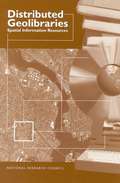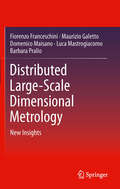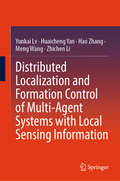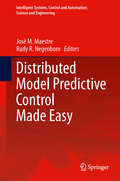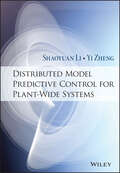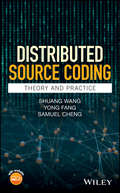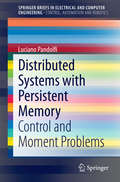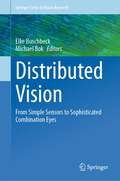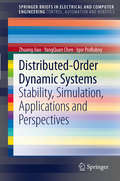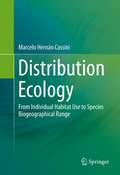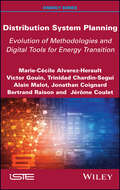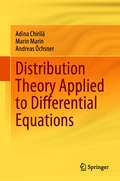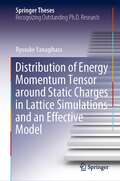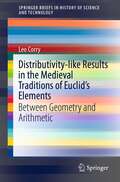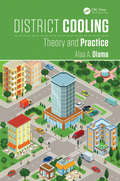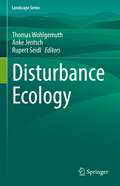- Table View
- List View
Distributed Coordination Control System: Application Scenarios and Countermeasures
by Yongnan JiaThis book is guided by the typical application scenarios of distributed coordination control strategies inspired by the collective behaviors of flocks of birds, schools of fish, swarm of herds, and so on. More importantly, it gives a complete flocking solution from mathematical modeling, theoretical derivation, simulation analysis to engineering application in detail. In general, all things in the world evolves from simple to complex, from individual to group, from individual intelligence to swarm intelligence. Therefore, swarm intelligence represents the development trend of artificial intelligence in the future. This book is suitable for natural science enthusiasts and other people who are interested in these collective phenomena. It can be used not only as a teaching material for control science engineering and computer science majors in colleges and universities, but also as a reference for professionals in the fields of control science, computer science, mathematics, and physics.
Distributed Coordination Theory for Robot Teams (Lecture Notes in Control and Information Sciences #490)
by Manfredi Maggiore Ashton Roza Luca ScardoviDistributed Coordination Theory for Robot Teams develops control algorithms to coordinate the motion of autonomous teams of robots in order to achieve some desired collective goal. It provides novel solutions to foundational coordination problems, including distributed algorithms to make quadrotor helicopters rendezvous and to make ground vehicles move in formation along circles or straight lines. The majority of the algorithms presented in this book can be implemented using on-board cameras. The book begins with an introduction to coordination problems, such as rendezvous of flying robots, and modelling. It then provides a solid theoretical background in basic stability, graph theory and control primitives. The book discusses the algorithmic solutions for numerous distributed control problems, focusing primarily on flying robotics and kinematic unicycles. Finally, the book looks to the future, and suggests areas discussed which could be pursued in further research. This book will provide practitioners, researchers and students in the field of control and robotics new insights in distributed multi-agent systems.
Distributed Drive Control Technology of Hub Motor (Key Technologies on New Energy Vehicles)
by Shaopeng Zhu Chao LyuThis book systematically introduces the two core technologies of hub motor and distributed drive control, and describes vehicle parameter estimation and dynamic modeling as the design basis of distributed drive control strategy based on the author's research results and engineering practice, starting from the introduction to distributed drive control of hub motor. The content systematically describes the specific control strategy design method of distributed drive and brake, and the software/hardware in-the-loop test technology for distributed drive control. The related intelligent driving technology based on distributed drive vehicle is also introduced in the book. This book can be used as a reference for automotive industry professionals engaged in new energy vehicle development, electric powertrain research, hub motor research, etc. It can also be used as a reference book for teachers and students majoring in automotive in colleges and universities. The basis of English translation of this book, originally in Chinese, was facilitated by artificial intelligence. The content was later revised by the author for accuracy.
Distributed Energy Management of Electrical Power Systems (IEEE Press Series on Power and Energy Systems)
by Wei Zhang Wen Yu Yinliang Xu Wenxin LiuGo in-depth with this comprehensive discussion of distributed energy management Distributed Energy Management of Electrical Power Systems provides the most complete analysis of fully distributed control approaches and their applications for electric power systems available today. Authored by four respected leaders in the field, the book covers the technical aspects of control, operation management, and optimization of electric power systems. In each chapter, the book covers the foundations and fundamentals of the topic under discussion. It then moves on to more advanced applications. Topics reviewed in the book include: System-level coordinated control Optimization of active and reactive power in power grids The coordinated control of distributed generation, elastic load and energy storage systems Distributed Energy Management incorporates discussions of emerging and future technologies and their potential effects on electrical power systems. The increased impact of renewable energy sources is also covered. Perfect for industry practitioners and graduate students in the field of power systems, Distributed Energy Management remains the leading reference for anyone with an interest in its fascinating subject matter.
Distributed Energy Resources: Solutions for a Low Carbon Society (Green Energy and Technology)
by Weijun GaoThe future of the distributed energy generation market is promising, with opportunities in the residential, commercial, and industrial sectors driven by increasing awareness of clean energy, greenhouse gas (GHG) emission reduction targets, and rising global demand for energy. This book focuses on UN Sustainable Development Goal 7, which aims to "ensure access to affordable, reliable, sustainable, and modern energy for all." It provides research results, applications, and case studies on the potential of distributed energy resources as a solution to building a low-carbon society. Coverage includes modeling and evaluation of distributed power systems, system maintenance and reliability, economic potential and implications of hydrogen energy systems, grid stabilization and carbon emission reduction, smart design, and the impact of energy penetration on public power grids. Case studies include the effects of renewable energy policies on solar photovoltaic energy in China, Germany, Japan, and the United States of America and a feasibility assessment of distributed energy systems in Shanghai. Distributed Energy Resources: Solutions for a Low Carbon Society will be a valuable resource for postgraduate students and researchers in energy systems, urban energy management, and renewable energy technologies and a reference guide for practicing engineers, urban energy planners, and energy system managers.
Distributed Energy Systems: Design, Modeling, and Control (Control Theory and Applications)
by Dmitri Vinnikov Ashutosh K. Giri Sabha Raj AryaThis book provides the insight of various topology and control algorithms used for power control in distributed energy power conversion systems such as solar, wind, and other power sources. It covers traditional and advanced control algorithms of power filtering including modelling and simulations, and hybrid power generation systems. The adaptive control, model predictive control, fuzzy-based controllers, Artificial Intelligence-based control algorithm, and optimization techniques application for estimating the error regulator gains are discussed. Features of this book include the following: Covers the schemes for power quality enhancement, and voltage and frequency control. Provides complete mathematical modelling and simulation results of the various configurations of the renewable energy-based distribution systems. Includes design, control, and experimental results. Discusses mathematical modelling of classical and adaptive control techniques. Explores recent application of control algorithm and power conversion. This book is aimed at researchers, professionals, and graduate students in power electronics, distributed power generation systems, control engineering, Artificial Intelligent-based control algorithms, optimization techniques, and renewable energy systems.
Distributed Generation: The Power Paradigm for the New Millennium
by Jan F. Kreider Ann-Marie BorbelyAs a result of deregulation, the US electric utility industry is undergoing a dramatic transformation with far-reaching technical and social consequences. At the heart of this transformation lies Distributed Generation (DG)-the substitution of centralized electricity production with smaller-scale technologies located in or near facilities and power
Distributed Geolibraries: Spatial Information Resources Summary of a Workshop
by National Research CouncilPresents the findings of the Workshop on Distributed Geolibraries: Spatial Information Resources, convened by the Mapping Science Committee of the National Research Council in June 1998
Distributed Large-Scale Dimensional Metrology
by Domenico Maisano Fiorenzo Franceschini Luca Mastrogiacomo Barbara Pralio Maurizio GalettoThe field of large-scale dimensional metrology (LSM) deals with objects that have linear dimensions ranging from tens to hundreds of meters. It has recently attracted a great deal of interest in many areas of production, including the automotive, railway, and shipbuilding sectors. Distributed Large-Scale Dimensional Metrology introduces a new paradigm in this field that reverses the classical metrological approach: measuring systems that are portable and can be easily moved around the location of the measured object, which is preferable to moving the object itself. Distributed Large-Scale Dimensional Metrology combines the concepts of distributed systems and large scale metrology at the application level. It focuses on the latest insights and challenges of this new generation of systems from the perspective of the designers and developers. The main topics are: coverage of measuring area,sensors calibration,on-line diagnostics,probe management, andanalysis of metrological performance.The general descriptions of each topic are further enriched by specific examples concerning the use of commercially available systems or the development of new prototypes. This will be particularly useful for professional practitioners such as quality engineers, manufacturing and development engineers, and procurement specialists, but Distributed Large-Scale Dimensional Metrology also has a wealth of information for interested academics.
Distributed Learning Ecosystems: Concepts, Resources, and Repositories
by Olaf Zawacki-Richter Michael Kerres Daniel Otto Gianna ScharnbergThis open-access book is based on the observation that learning ecosystems are increasingly established in higher education institutions. However, an important aspect that is still missing is their interconnectedness. Consequently, the book intends to close this gap by introducing the concept of a distributed learning ecosystem (DLE). A DLE follows the idea of establishing an interlinkage between decentralised learning ecosystems (consisting of content repositories and educational resources) and thus serves as an integrated approach that enables learners to access and use learning content and share resources.
Distributed Localization and Formation Control of Multi-Agent Systems with Local Sensing Information
by Hao Zhang Meng Wang Yunkai Lv Huaicheng Yan Zhichen LiThis book mainly focuses on the key technologies and important issues related to localization estimation and formation control for networked multi-agent systems. Chapter 1 introduces the concepts of multi-agent systems, fundamental issues in localization and formation, research progress both at home and abroad, and the theory of system stability. Chapters 2–8 present research results on distributed localization estimation under conditions such as random deployment, non-ideal channels, random noise, varying-trajectory length, sensor multiplicative failure, and local bearing measurement. Chapter 9 focuses on integrated research progress in localization estimation and formation control for multi-agent systems under local perception conditions. The book demonstrates the effectiveness and superiority of the theoretical methods through simulation and physical examples.
Distributed Model Predictive Control Made Easy
by José M. Maestre Rudy R. NegenbornThe rapid evolution of computer science, communication, and information technology has enabled the application of control techniques to systems beyond the possibilities of control theory just a decade ago. Critical infrastructures such as electricity, water, traffic and intermodal transport networks are now in the scope of control engineers. The sheer size of such large-scale systems requires the adoption of advanced distributed control approaches. Distributed model predictive control (MPC) is one of the promising control methodologies for control of such systems. This book provides a state-of-the-art overview of distributed MPC approaches, while at the same time making clear directions of research that deserve more attention. The core and rationale of 35 approaches are carefully explained. Moreover, detailed step-by-step algorithmic descriptions of each approach are provided. These features make the book a comprehensive guide both for those seeking an introduction to distributed MPC as well as for those who want to gain a deeper insight in the wide range of distributed MPC techniques available.
Distributed Model Predictive Control for Plant-Wide Systems
by Yi Zheng Shaoyuan LiA comprehensive examination of DMPC theory and its technological applications • A comprehensive examination of DMPC theory and its technological applications from basic through to advanced level• A systematic introduction to DMPC technology providing classic DMPC coordination strategies, analysis of their performance, and design methods for both unconstraint and constraint systems• Includes the system partition methods, coordination strategies, the performance analysis and how to design stabilized DMPC under different coordination strategies• Presents useful theories and technologies which can be used in many different industrial fields, such as the metallurgical process and high speed transport, helping readers to grasp the procedure of using the DMPC• Reflects the authors’ combined research in the area, providing a wealth of and current and background information
Distributed Secondary Control of Microgrid Systems
by Haoming Liu Muhammad Yasir Khan Jingjing ZhaiThis book presents a detailed description of the transition from the traditional power system to the microgrid (MG) system.The authors introduce the basic concepts of an MG system along with its different operating modes and classifications. The various benefits, challenges, and technical aspects of an MG are highlighted. They demonstrate different control strategies that are applied at different levels of the control hierarchy, particularly the distributed secondary control architecture. Furthermore, the adaptive techniques-based distributed schemes, a distributed architecture-based synchronization controller, and a delay-independent buffer-free distributed controller are proposed for the MG system.This book can be useful for senior undergraduate students, postgraduate students, and researchers of electrical power engineering and system control.
Distributed Source Coding: Theory and Practice
by Samuel Cheng Shuang Wang Yong FangDistributed source coding is one of the key enablers for efficient cooperative communication. The potential applications range from wireless sensor networks, ad-hoc networks, and surveillance networks, to robust low-complexity video coding, stereo/Multiview video coding, HDTV, hyper-spectral and multispectral imaging, and biometrics. The book is divided into three sections: theory, algorithms, and applications. Part one covers the background of information theory with an emphasis on DSC; part two discusses designs of algorithmic solutions for DSC problems, covering the three most important DSC problems: Slepian-Wolf, Wyner-Ziv, and MT source coding; and part three is dedicated to a variety of potential DSC applications. Key features: Clear explanation of distributed source coding theory and algorithms including both lossless and lossy designs. Rich applications of distributed source coding, which covers multimedia communication and data security applications. Self-contained content for beginners from basic information theory to practical code implementation. The book provides fundamental knowledge for engineers and computer scientists to access the topic of distributed source coding. It is also suitable for senior undergraduate and first year graduate students in electrical engineering; computer engineering; signal processing; image/video processing; and information theory and communications.
Distributed Systems with Persistent Memory
by Luciano PandolfiThe subject of the book includes the study of control problems for systems which are encountered in viscoelasticity, non-Fickian diffusion and thermodynamic with memory. The common feature of these systems is that memory of the whole past history persists in the future. This class of systems is actively studied now, as documented in the recent book. This book will attract a diversified audience, in particular, engineers working on distributed systems, and applied mathematicians. Background of mathematics are the elements of functional analysis, which is now standard among people working on distributed systems, and the author describes very clearly the instruments which are used at every step.
Distributed Vision: From Simple Sensors to Sophisticated Combination Eyes (Springer Series in Vision Research)
by Elke Buschbeck Michael BokThis volume explores the diversity of distributed eyes and other unusual visual systems in nature. It compares the unique themes of optics, neural processing, and behavioral control that emerge from these visual systems with more-canonical eyes. This volume attempts to answer a number of questions about distributed visual systems. What are distributed visual systems good for, how do they function, and why have they arisen independently in so many phyla? Why are eye designs and visual system arrangements much more diverse in invertebrates? Each chapter includes an overview of the visual systems that exist in their group of animals, relates vision to ecology, and takes a comparative approach.
Distributed-Order Dynamic Systems
by Yangquan Chen Igor Podlubny Zhuang JiaoDistributed-order differential equations, a generalization of fractional calculus, are of increasing importance in many fields of science and engineering from the behaviour of complex dielectric media to the modelling of nonlinear systems. This Brief will broaden the toolbox available to researchers interested in modeling, analysis, control and filtering. It contains contextual material outlining the progression from integer-order, through fractional-order to distributed-order systems. Stability issues are addressed with graphical and numerical results highlighting the fundamental differences between constant-, integer-, and distributed-order treatments. The power of the distributed-order model is demonstrated with work on the stability of noncommensurate-order linear time-invariant systems. Generic applications of the distributed-order operator follow: signal processing and viscoelastic damping of a mass-spring set up. A new general approach to discretization of distributed-order derivatives and integrals is described. The Brief is rounded out with a consideration of likely future research and applications and with a number of MATLAB® codes to reduce repetitive coding tasks and encourage new workers in distributed-order systems.
Distribution Ecology
by Marcelo Hernán CassiniThis book brings together a set of approaches to the study of individual-species ecology based on the analysis of spatial variations of abundance. Distribution ecology assumes that ecological phenomena can be understood when analyzing the extrinsic (environmental) or intrinsic (physiological constraints, population mechanisms) that correlate with this spatial variation. Ecological processes depend on geographical scales, so their analysis requires following environmental heterogeneity. At small scales, the effects of biotic factors of ecosystems are strong, while at large scales, abiotic factors such as climate, govern ecological functioning. Responses of organisms also depend on scales: at small scales, adaptations dominate, i.e. the ability of organisms to respond adaptively using habitat decision rules that maximize their fitness; at large scales, limiting traits dominate, i.e., tolerance ranges to environmental conditions.
Distribution System Planning: Evolution of Methodologies and Digital Tools for Energy Transition
by Bertrand Raison Marie-Cecile Alvarez-Herault Victor Gouin Trinidad Chardin-Segui Alain Malot Jonathan Coignard Jerome CouletDistribution systems drive energy and societal transition. System planning enables investments to be made in the right place, at the right time and with the right technology. Distribution System Planning is centered on the evolution of planning methods that will best support this transition, and describes the historical context and concepts that enable planning, its challenges and key influencing factors to be grasped. It also analyzes the impact of the development of renewable and decentralized energy resources, government recommendations and distributor initiatives to promote their integration. Through the use of case studies, this book provides examples of how planning methodologies have evolved, as well as an overview of new and emerging solutions.
Distribution Theory Applied to Differential Equations
by Andreas Öchsner Marin Marin Adina ChirilăThis book presents important contributions to modern theories concerning the distribution theory applied to convex analysis (convex functions, functions of lower semicontinuity, the subdifferential of a convex function). The authors prove several basic results in distribution theory and present ordinary differential equations and partial differential equations by providing generalized solutions. In addition, the book deals with Sobolev spaces, which presents aspects related to variation problems, such as the Stokes system, the elasticity system and the plate equation. The authors also include approximate formulations of variation problems, such as the Galerkin method or the finite element method. The book is accessible to all scientists, and it is especially useful for those who use mathematics to solve engineering and physics problems. The authors have avoided concepts and results contained in other books in order to keep the book comprehensive. Furthermore, they do not present concrete simplified models and pay maximal attention to scientific rigor.
Distribution of Energy Momentum Tensor around Static Charges in Lattice Simulations and an Effective Model (Springer Theses)
by Ryosuke YanagiharaThe energy momentum tensor (EMT) is one of the most fundamental observables in physics. Recently, a novel method to define EMT on the basis of the gradient-flow formalism has been proposed. It turned out that the EMT operator can be constructed even on the lattice with the method, which enables non-perturbative computations. This approach has been successfully applied to the analyses on thermodynamic quantities.This book presents the study on spatial EMT distributions around static charges via the gradient flow in lattice simulations based on SU(3) Yang-Mills theory. Static charges are employed as probes to explore complex quantum systems, and EMT then characterizes the response of vacuum as well as hot medium under the existence of the charges, which significantly provides profound and novel insights into the non-perturbative phenomena, such as the confinement of quarks. In addition, the book treats the study on the EMT distribution around a magnetic vortex in the Abelian-Higgs model, which is compared with the lattice result. These achievements open up various future studies for revealing non-trivial aspects of the strong interaction.The book also includes well-organized reviews on general properties of EMT, lattice gauge theory and the gradient-flow formalism with its application to the definition of EMT. They are useful for students and young researchers as a brief introduction to this field.
Distributivity-like Results in the Medieval Traditions of Euclid's Elements: Between Geometry and Arithmetic (SpringerBriefs in History of Science and Technology)
by Leo CorryThis book provides a fresh view on an important and largely overlooked aspect of the Euclidean traditions in the medieval mathematical texts, particularly concerning the interrelations between geometry and arithmetic, and the rise of algebraic modes of thought. It appeals to anyone interested in the history of mathematics in general and in history of medieval and early modern science.
District Cooling: Theory and Practice (Heat Transfer #7)
by Alaa A. OlamaDISTRICT COOLING: THEORY and PRACTICE provides a unique study of an energy cogeneration system, set up to bring chilled water to buildings (offices, apartment houses, and factories) needing cooling for air conditioning and refrigeration. In winter, the source for the cooling can often be sea water, so it is a cheaper resource than using electricity to run compressors for cooling. The related technology of District Heating has been an established engineering practice for many years, but District Cooling is a relatively new technology now being implemented in various parts of the world, including the USA, Arab Emirates and Kuwait, and Saudi Arabia. Existing books in the area are scarce, and do not address many of the crucial issues facing nations with high overall air temperatures, many of which are developing District Cooling plans using sea water. DISTRICT COOLING: THEORY & PRACTICE integrates the theory behind district cooling planning with the practical engineering approaches, so it can serve the policy makers, engineers, and planners whose efforts have to be coordinated and closely managed to make such systems effective and affordable. In times of rising worldwide temperatures, District Cooling is a way to provide needed cooling with energy conservation and sustainability. This book will be the most up-to-date and comprehensive study on the subject, with Case Studies describing real projects in detail.
Disturbance Ecology (Landscape Series #32)
by Thomas Wohlgemuth Anke Jentsch Rupert SeidlThis edited work presents a multi-faceted view on the causes and consequences of disturbance in ecosystems. Vegetation can be affected by a variety of different disturbances such as wind, floods, fire, and insect attack, leading to an abrupt change in live biomass. Disturbance is a motor of vegetation dynamics, but also sensitive to climate change and poses a challenge for ecosystem management. Readers will discover the global distribution of disturbance regimes and learn about the importance of disturbances for biodiversity and the evolution of plant and animal life. The book provides a Central European perspective on disturbance ecology, and addresses important disturbance agents such as fire, wind, avalanches, tree diseases, insect defoliators, bark beetles and large herbivores in dedicated chapters. It furthermore includes chapters on anthropogenic disturbances in forests and grasslands. The impact of climate change on disturbance regimes and approaches to address disturbance risks in ecosystem management are discussed in concluding chapters. Within the 18 chapters 14 textboxes highlight current topics of disturbance ecology and provide deeper methodological insights into the field. Disturbances strongly shape our landscapes and maintain our biodiversity. A better understanding of their ecology is thus fundamental for contextualizing the dynamic changes in our environment. This book is a valuable resource for students and practitioners interested in disturbances and their management.
